Thursday 15 September 2016
White: K. French (95) - Black: K. Nevols (134)
Another opponent who is better than the grade suggests. I knew that he was a master of defence - as I discovered last year (Game 9) where he found opportunities after I went wrong in my attack, so I knew I should be on my guard and not try anything too clever.
1. d4 Nf6
As I said, I have been looking at the Kings Indian Defence, although struggling a bit with the lack of space it sometimes allows. However, I did not do too badly with the opening last time so it was worth another shot.
2. c4 g6
3. Nc3 Bg7
4. e4 d6
5. Nf3 O-O
6. Be2 e5
7. d5
White goes into the classical line - the Petrosian system. The idea is to follow with Bg5 to stall Black's kingside play and build up the White attack on the queenside.
7. .... a5
The standard Black counter. The plan is to plant a knight on the c5 square where it won't be molested by pawns.
8. O-O Na6
9. a3
9. Bg5 is considered more accurate, but White decides to get moving on the queenside.
9. ... Nc5
10. Bd3 a4?!
Poor. The idea is simple - to hold up White's pawn advances. However, this pawn is out on a limb and Black now spends most of the game defending it. Keeping it on a5 - with b6 if necessary - was far better.
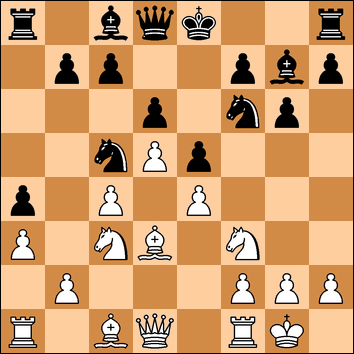
11. Bc2!
White jumps on Black's self-inflicted weakness.
11. ... Bd7
12. Be3 Qe8
I felt this was forced and was already regretting my mistake. I spent some time looking at 12. .. Qe7 and sacrificing the a-pawn. Of course it is not a sacrifice at all. After 12. .. Qe7 13. Bxc5 Nxc5 14. Nxa4 then simply 14. .. Nxe4 and with ideas of f5 to come Black is better.
The main drawback I always find when I play the Kings Indian Defence is the lack of space with which to move my pieces. Already I feel boxed in.
13. Bxc5?!
This is well known to be dubious in the Kings Indian systems. It looks good for White to break up Black's pawns in this way. However, the loss of the black-squared bishop weakens White considerably. Black's counterpart bishop now has no opposition along the c1-h6 diagonal.
13. .. dxc5
14. Re1
Defending the e-pawn and releasing the queen's knight for action. Now Black should play 14. .. Ra6! (This move does come along but not until much later). This would hold up any White plans based around d6 and in the log term prepare to swing across to the kingside..
14. ... Nh5?
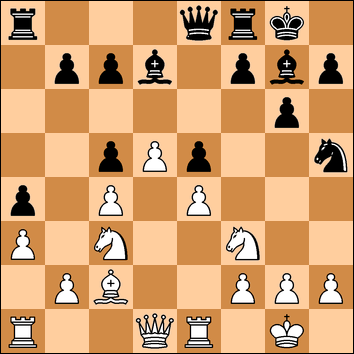
This is a mistake. The plan is to come to the f4 square and, with Bh6, start to think about how I can use the Black squares.
And while White was thinking I saw 15. d6! and immediately started thinking how to deal with it. 15. .. cxd6 16. Qxd6 just looked too horrible (16. ... Qe6 17. Rad1 and the pressure builds) whereas 15. .. Qd8 16. dxc7 Qxc7 just loses the a-pawn and White has Nd5 coming in.
The computer mentions the line 15. d6 cxd6 16. Qxd6 Bg4 17. Qxc5 Nf4 and then if 18. Qb4 then Bxf3 19. gxf3 Qd8 20. Ne2 (20. Kg1?? Qd2) Qg5+ 21. Ng3 h5 and Black gets a strong attack so 18. Qe3 is better. Black might still have compensation for his pawn but the long term does not look good.
15. Ne2?
To my relief, White decides to retreat, and this now gives me the time to start an attack going.
15. ..... Qe7
Black should play 15. .. Ra6 as White can now just go back with 16. Nc3 Qe8 and then has a second opportunity to push the pawn to d6.
16. Ng3
In my opinion, not a good square for the knight. It does not do anything and becomes a target for the h-pawn.
16. ... Nf4
17. Nd2 h5!
White retreated his knight presumably to prevent Bg4 but Black can now advance.
18. Re3 Bh6
19. Rc3 h4
20. Ne2
Black now wins a pawn. The alternative was 20. Ngf1 Qg5 21. g3 Nh3+ 22. Kg2 hxg3 23. hxg3 Qf6 with an attack.
20 ... Nxg2
The drawback of winning the pawn is the exchange of queens but being unable to see a clear win - I resign myself to that consequence. (The computer confirms this fact).
21. Kxg2 Qg5+
22. Kh1 Qxd2
23. Qxd2 Bxd2
24. Rd3 Bh6
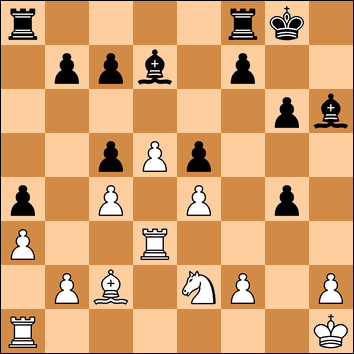
So where are we now? I am a pawn up, I have a good unopposed black-squared bishop, and good long term possibilities. On the minus side, I am still lumbered with that pawn on a4 which forces a defence and restricts the movement of my rook and the other bishop. So the plan - to try to exploit those weak areas around his king - and I did not see the chances of attacking the queenside.
Now White should play 25. Nc3 to improve the position of his knight, keep hitting a4, and hold up Black's queenside play.
25. f3 Ra6
At last! This should have been played ages ago. However Black could have improved with 25. .. b5! If 26. cxb5 Bxb5 wins material. So 26. b3 and then 26. .. Rfb8! is strong.
26. Nc3 g5
Better would be 26. .. f5.
27. R3d1 Rfa8
The simple purpose is to overprotect the a4 pawn in order to free the other rook for action. Not for the first time, I was cursing my earlier move of a4.
28. Rg1 Rg6
29. Raf1 Kh8
White consistently rejects the Nb5 move - perhaps as he did not like the prospect of Bxb5. Black now shuffles his rooks around and tries to find something to do.
30. Rd1 Rb6
31. Rb1 Rf6
32. Bd1 Rg6
33. Bc2 g4
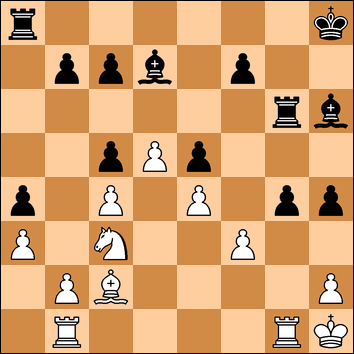
Getting impatient I decide I might as well get on with it. The plan was 34. fxg4 Bxg4 35. Bd1 and then think about whether I want to exchange bishops or not.
34. Bd1?
A considerable surprise. White does not take the chance to exchange his weak f-pawn and allows me to advance and get a passed pawn.
34. .. g3
35. hxg3 hxg3
36. Kg2 Bf4
37. Rh1+ Kg7
This was presumably White's plan. Black's advance is held up and he gets the h-file.
38. Bc2 Raa6
My logic is that if I can get rid of the rooks, and he swaps his knight for the bishop on f4 with the reply exf4, I should have a won bishop ending.
39. Ne2 Rh6
40. Nxf4 exf4
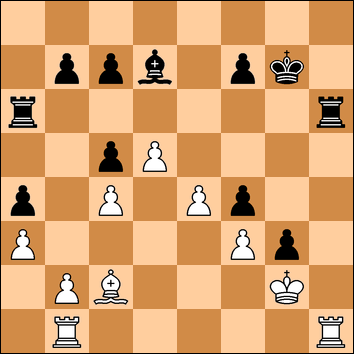
Now I saw that White has the chance to play 41. e5, freeing his bishop and counter playing in the centre. Black could play 41. .. Rxh1 42. Rxh1 Rb8 or I could stick to the plan with 42. .. Rh6 43. Rxh6 Kxh6 then move the king towards the centre and try to get b5 in.
41. Rbe1 Rxh1
42. Rxh1 Rh6
43. Rxh6 Kxh6
OK, the rooks are now gone. White now has another chance to consider e5.
44. b3
But I was glad to see this. A chance to get rid of that pawn which had been plaguing me the whole game and a gain of time to get my king in the centre.
44. ... axb3
45. Bxb3 Kg5
46. Bc2 Kf6
That puts an end to e5 and now the win must be simple. Advance the king and pick up the pawns.
47. a4 b6
48. Bd1 Ke5
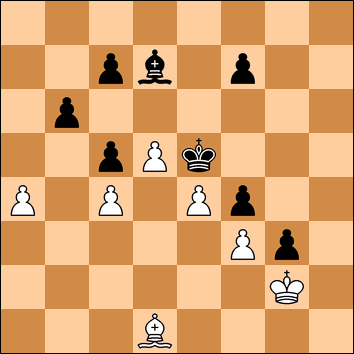
49. Be2
White jettisons a second pawn in order to task the bishop with the job of patrolling the g2 square and freeing up the king.
49. ... Bxa4
50. Bf1 Kd4
51. Kh3 Bd7+
52. Kh4 f6
53. Kh5 b5
54. cxb5 Bxb5
The second passed pawn and now the game is over.
55. Bg2 c4
56. Kg4 Ke5
57. Kh3 c3
58. Kh4 c2
59. Kh5 c1 (Q)
60. Kg6 Qc5
61. Kh6 Qf8+
62. Kh5 Qh8+
63. Kg6 Be8++
I was glad to win this game - a tough battle - and the moves a4 (bad) and Ra6 (good) were noted in my kings defence memory bank.
No comments:
Post a Comment